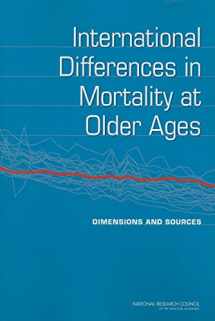
International Differences in Mortality at Older Ages: Dimensions and Sources
Book details
Summary
Description
In 1950 men and women in the United States had a combined life expectancy of 68.9 years, the 12th highest life expectancy at birth in the world. Today, life expectancy is up to 79.2 years, yet the country is now 28th on the list, behind the United Kingdom, Korea, Canada, and France, among others. The United States does have higher rates of infant mortality and violent deaths than in other developed countries, but these factors do not fully account for the country's relatively poor ranking in life expectancy.
International Differences in Mortality at Older Ages: Dimensions and Sources examines patterns in international differences in life expectancy above age 50 and assesses the evidence and arguments that have been advanced to explain the poor position of the United States relative to other countries. The papers in this deeply researched volume identify gaps in measurement, data, theory, and research design and pinpoint areas for future high-priority research in this area.
In addition to examining the differences in mortality around the world, the papers in International Differences in Mortality at Older Ages look at health factors and life-style choices commonly believed to contribute to the observed international differences in life expectancy. They also identify strategic opportunities for health-related interventions. This book offers a wide variety of disciplinary and scholarly perspectives to the study of mortality, and it offers in-depth analyses that can serve health professionals, policy makers, statisticians, and researchers.
- Front Matter
- 1 Introduction and Overview--Eileen M. Crimmins, Samuel H. Preston, and Barney Cohen
- Part I: Levels and Trends
- 2 Diverging Trends in Life Expectancy at Age 50: A Look at Causes of Death--Dana A. Glei, France Meslé, and Jacques Vallin
- 3 Are International Differences in Health Similar to International Differences in Life Expectancy?--Eileen M. Crimmins, Krista Garcia, and Jung Ki Kim
- Part II: Identifying Causal Explanations
- 4 Contribution of Smoking to International Differences in Life Expectancy--Samuel H. Preston, Dana A. Glei, and John R. Wilmoth
- 5 Divergent Patterns of Smoking Across High-Income Nations--Fred Pampel
- 6 Can Obesity Account for Cross-National Differences in Life-Expectancy Trends?--Dawn E. Alley, Jennifer Lloyd, and Michelle Shardell
- 7 The Contribution of Physical Activity to Divergent Trends in Longevity--Andrew Steptoe and Anna Wikman
- 8 Do Cross-Country Variations in Social Integration and Social Interactions Explain Differences in Life Expectancy in Industrialized Countries?--James Banks, Lisa Berkman, and James P. Smith with Mauricio Avendano and Maria Glymour
- Part III: The U.S. Health System
- 9 Low Life Expectancy in the United States: Is the Health Care System at Fault?--Samuel H. Preston and Jessica Ho
- 10 Can Hormone Therapy Account for American Women's Survival Disadvantage?--Noreen Goldman
- Part IV: Inequality
- 11 Do Americans Have Higher Mortality Than Europeans at All Levels of the Education Distribution?: A Comparison of the United States and 14 European Countries--Mauricio Avendano, Renske Kok, Maria Glymour, Lisa Berkman, Ichiro Kawachi, Anton Kunst, and Johan Mackenbach with support from members of the Eurothine Consortium
- 12 Geographic Differences in Life Expectancy at Age 50 in the United States Compared with Other High-Income Countries--John R. Wilmoth, Carl Boe, and Magali Barbieri
- Part V: International Case Studies
- 13 Renewed Progress in Life Expectancy: The Case of the Netherlands--Johan Mackenbach and Joop Garssen
- 14 The Divergent Life-Expectancy Trends in Denmark and Sweden - and Some Potential Explanations--Kaare Christensen, Michael Davidsen, Knud Juel, Laust Mortensen, Roland Rau, and James W. Vaupel
- Biographical Sketches of Contributors


We would LOVE it if you could help us and other readers by reviewing the book
Book review



